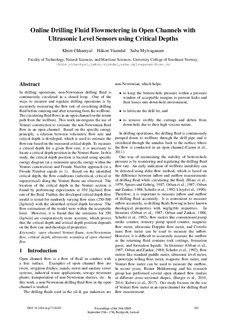Online Drilling Fluid Flowmetering in Open Channels with Ultrasonic Level Sensors using Critical Depths
Journal article, Peer reviewed
Published version
Permanent lenke
http://hdl.handle.net/11250/2466961Utgivelsesdato
2017Metadata
Vis full innførselSamlinger
Sammendrag
In drilling operations, non-Newtonian drilling fluid is continuously circulated in a closed loop. One of the ways to monitor and regulate drilling operations is by accurately measuring the flow rate of circulating drilling fluid before entering and after returning from the wellbore. The circulating fluid flows in an open channel on the return path from the wellbore. This work investigates the use of Venturi constriction to estimate the non-Newtonian fluid flow in an open channel. Based on the specific energy principle, a relation between volumetric flow rate and critical depth is developed, which is used to estimate the flow rate based on the measured critical depth. To measure a critical depth for a given flow rate, it is necessary to locate a critical depth position in the Venturi flume. In this study, the critical depth position is located using specific energy diagram (at a minimum specific energy within the Venturi constriction) and Froude Number approach (at a Froude Number equals to 1). Based on the identified critical depth, the flow conditions (subcritical, critical or supercritical) along the Venturi flume are observed. The location of the critical depth in the Venturi section is found by performing experiments at 350 [kg/min] flow rate of the fluid. Further, the developed critical depth flow model is tested for randomly varying flow rates (250-500 [kg/min]) with the identified critical depth location. The flow estimations of the model were within the acceptable limit. However, it is found that the estimates for 350 [kg/min] are comparatively more accurate, which proves that the critical depth and critical depth position depends on the flow rate and rheological properties.

